Perennials. Lateral roots fusiform or tuberous. Stems 30-70 cm tall, glabrous. Lower leaves biternate; petioles 20 cm long, petiolules 3.5—10 cm long; leaflets nearly all or all segmented, leaflets/leaf segments 17-45 in number, lanceolate, oblanceolate, or broad—linear, 3.5—11 cm long, 1.6-3.8 cm wide, always lobed, with 2-5 obtuse to acute lobes, often with bristles along veins above, slightly glaucous, glabrous or very occasionally sparsely pubescent beneath. Flowers solitary and terminal; involucrate bracts usually 2 or 3, less frequently 1 or 4 in number, leaf—like; sepals 3-5 in number, green or green but purple at the periphery, mostly rounded at the apex, 2-3.5 cm long, 2-3 cm wide; corolla red or dark red, cup-shaped, petals 7-10 in number, obovate, entire or incised at the apex, 4-5 cm long, 2.5-3 cm wide; filaments yellow or red; disk c. 1 mm high, waved, white; carpels mostly 2 or 3, rarely 1 or 4 in number, tomentose, hairs c. 2.5 mm long; stigmas sessile, yellow, 1.8-3.3 mm wide. Follicles 3.5 cm long. Seeds ovoid—oblong, black, lucid, 8-10 mm long, 5-6 mm wide.
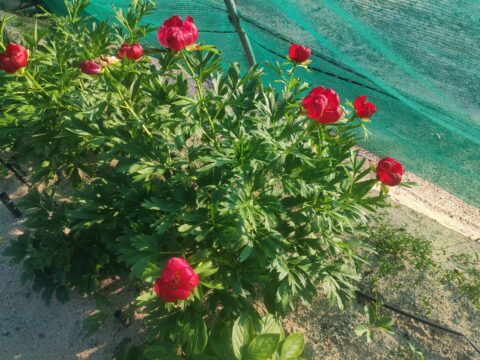
Paeonia peregrina. Copyright Koen Hurtekant
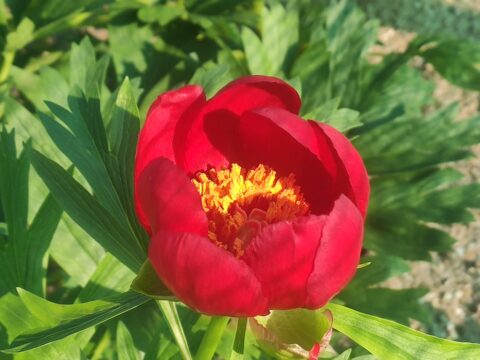
Paeonia peregrina. Copyright Koen Hurtekant
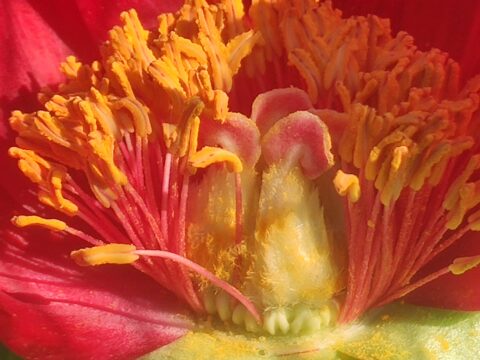
Paeonia peregrina. Copyright Koen Hurtekant
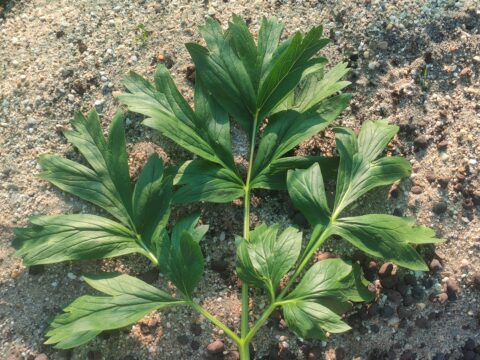
Paeonia peregrina. Copyright Koen Hurtekant
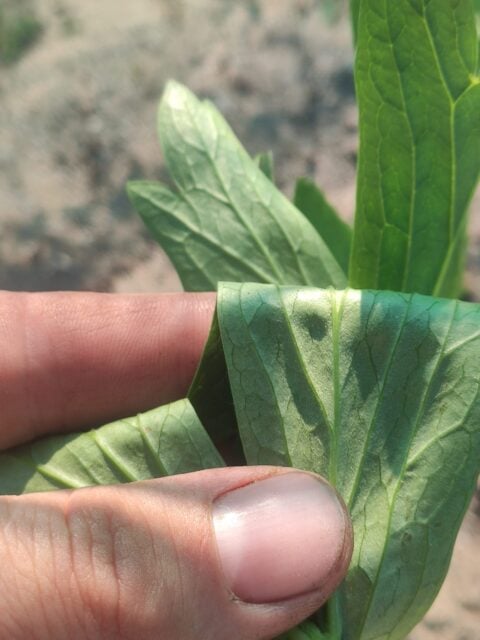
Paeonia peregrina. Copyright Koen Hurtekant
Chromosome number: 2n=20 (Dark, 1936; Langlet, 1927; Stern, 1944; Sushnik & Lovka, 1973; Tzanoudakis, 1977, 1983; Uspenskaya & Solovyeva, 1991; the present work with the voucher: Turkey, Ankara Prov., D. Y. Hang et al., H02201 (A, BM, CAS, K, MO,PE)). However, Sopova (1971) reports both 2n = 10 and 2n = 20 from Macedonia.
Growing mostly in deciduous broad-leaved forests, pine forests or mixed forests, less frequently in grasses. The species prefers calcarious soils and is found usually at altitudes from 50 to 1,500 m. Albania, Bulgaria, Greece, Italy (Mt San Donato di Ninea), Macedonia, Moldova (Uspenskaya & Solovyeva, 1991; Krupkina, 1996), Romania, Serbia and Turkey.
The most distinct character of Paeonia peregrina is its always teeth-lobed leaflets or segments, which distinguish it readily from P. officinalis and P. saueri D. Y. Hong, X. Q. Wang & D. M. Zhang. The other distinct characters are tuberous or fusiform lateral roots, leaflets or segments often with bristles along veins on the upper surface, and dark-red and cup-shaped corollas.
The identity of Paeonia peregrina Mill. had been problematic for a century and a half since its description as new. Miller (1768) described this taxon rather clearly as “foliis difformiter lobatis, lobis incises”, “with a deep red flower” and “growing naturally in the Levant (ca. 15 km N of Istanbul)”. However, later authors failed to follow Miller’s description. Sims (1807) followed the locality of P. peregrina, the Levant, but not the characters, and his “P. peregrina” is actually a new species, described as P. arietina by Anderson (1818). Anderson (1818) stated: “P. peregrina, de Candolle informs us, is a native of the mountains of Provence and Languedoc, chiefly near Montpellier…..” and he also cited “Bot. Mag. 1050”, which actually refers to P. arietina. Furthermore, he described the peony from Constantinople (Istanbul) as a new species, P. decora (Anderson, 1818). It is clear, therefore, that Anderson (1818) treated P. officinalis subsp. huthii from S France as P. peregrina, while describing the real P. peregrina as P. decora. Unfortunately, de Candolle (1818, 1824), Baker (1884), Lynch (1890), and Huth (1891) all followed Anderson (1818). It was Stapf (1918) who clarified the persisting confusion and correctly illustrated P. peregrina for the first time.
Paeonia tartarica Mill. (1768) was described by Stern (1946) as being “non satis nota”, and thus no taxonomical treatment was given by him or by succeeding authors. However, Miller’s description is clear, “The seeds…from the Levant (N of Istanbul)”, “The roots…oblong fleshy tubers or knobs…leaves composed of several lobes, which are irregular in shape and size, some of them having but six, and others have eight or ten spear-shaped lobe…”. This description fits P. peregrina Mill. well and better than any other species.
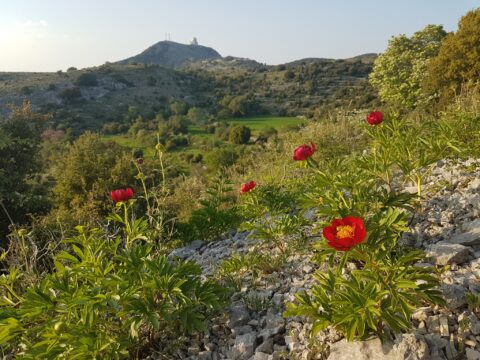
Copyright Liberto Dario. Paeonia peregrina on Lefkada island (Greece). Full sun and limestone scree for this redder than red species that also appears on the mainland and in less harsh conditions.”
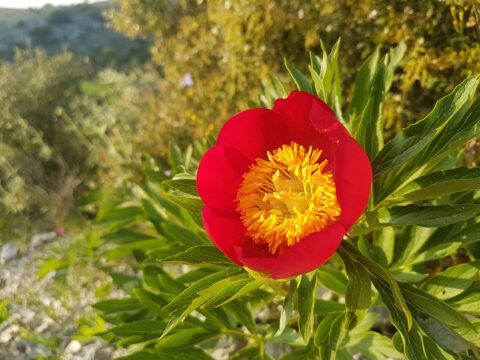
Copyright Liberto Dario. Paeonia peregrina on Lefkada island (Greece).
- Hong, De-Yuan. “Peonies of the World. Taxonomy and phytogeography.” Kew: Royal Botanic Gardens, 2010, p. 215-216.[↩]